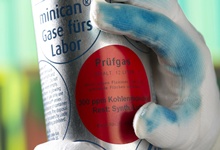Gloves that warn of toxic substance in the air
11 May 2013
Employees exposed to risks will only have to put on a glove in order to receive a toxic substance warning, as a new textile material identifies poisonous substances, and points them out immediately.
Employees in chemical production, semiconductors or in laboratories are frequently exposed to harmful substances. The problem is that many of these aggressive substances are imperceptible to human senses, which makes handling them risky.
 |
| The sensor glove turns blue in the presence of hazardous substances. (© Fraunhofer EMFT) |
While a broad range of solutions for employers to protect their staff from hazardous substances exist, ranging from highly sensitive measuring equipment to heat-imaging cameras, a new solution is on its way.
Researchers at the Fraunhofer Research Institution for Modular Solid State Technologies (EMFT) in Regensburg have engineered a glove that recognises if toxic substances are present in the surrounding air.
The protective glove is equipped with custom-made sensor materials and indicates the presence of toxic substances by changing colours.
The Fraunhofer scientists adapted the materials to the corresponding analytes, and thus, the application. The colour change – from colourless (no toxic substance) to blue (toxic substance detected), for example that warn employee immediately.
''By synthesising the adapted colour sensor materials, we can detect gases like carbon monoxide, for example, or hydrogen sulfide. Still, this protective gear represents only one potential area of application. Sensor materials could also be deployed for the quick detection of leaks in gas lines,'' explains Dr. Sabine Trupp, head of the Fraunhofer EMFT Sensor Materials group.
The team of researchers will exhibit this occupational safety article of clothing at Fraunhofer's joint exhibition booth at the Sensor + Test trade show in Nuremberg from 14 to 16 May.
Tailor-made indicator dyes
The warning signal is triggered by an indicator dye integrated into the glove that reacts to the presence of analytes, in this case, the toxic substances. Experts at EMFT used a variety of techniques in order to furnish textiles with sensor-activated dyes.
The sensor-activated dyes are applied to the clothing with the customary dye and print process, for example, by affixing them in an immersion bath. Previously, the researchers used targeted chemical modification to adapt the colour molecules to the fiber properties of the respective textile.
Alternatively, the textiles can also be coated with sensor particles that are furnished with sensor dyes. For this, the scientists integrated the dye molecules either into commercial pigments or built them up on an entirely synthetic basis. The pigments are then manufactured according to the customary textile finishing process, for instance, the sensor particles are also suitable for silkscreening. ''Which version we opt for depends on the requirements of the planned application,'' says Trupp.
The challenge lies foremost in the tailored development of sensor dyes. ''The dye molecule must detect a specific analyte in a targeted manner – only then will a chemical reaction occur. Moreover, the dye must adhere securely; it cannot disappear due to washing. We aim for the customer's preferences in the color selection as well. All of these aspects must be kept in mind when developing the molecule and pigment properties,'' explains Trupp.
The expert already has new ideas about how the solution could be developed further. For example, a miniaturized sensor module, integrated into textiles, could record toxic substances, store the measurement data and even transmit them to a main unit. This way, you could document how frequently an individual within a hazardous environment was exposed to poisonous concentrations over a longer period of time.
The researchers also envision other potential applications in the foodstuffs industry: In the future, color indicator systems integrated into foils or bottle closures are intended to make the quality status of the packaged foods visible.
Because the sell-by date does not represent a guarantee of any kind. Foodstuffs may often spoil prematurely - unnoticed by the consumer - due to a packaging error, or in the warehousing, or due to disruptions in the refrigeration chain. Oil-based and fat-containing products are specifically prone to this, as are meats, fish and ready meals.













.jpg)






.jpg)









